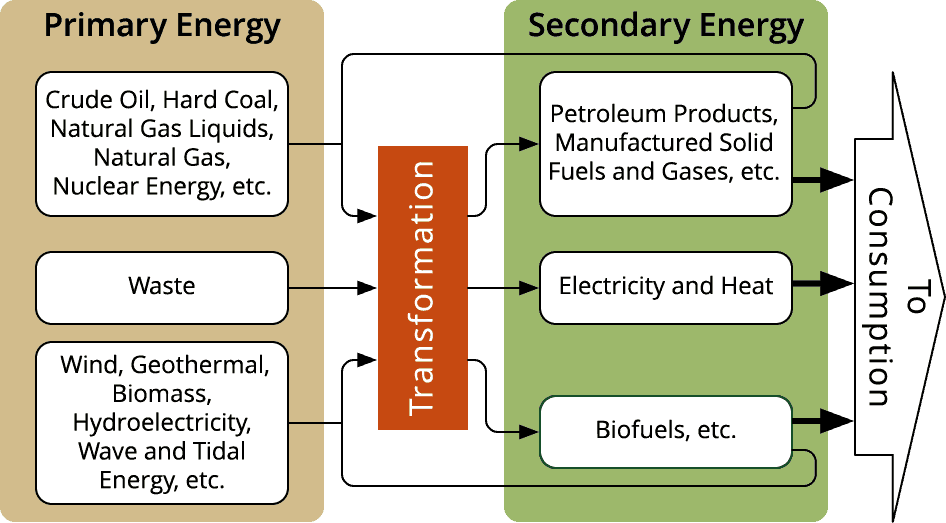One of the most common questions we get and one of the biggest concerns we try to address at Watt Watchers of Texas is the difference between primary and secondary energy. In order to effectively teach your students about the many benefits of participating in the reduction of your school’s energy consumption, they must first understand this difference.
At Watt Watchers of Texas, we have plenty of resources and information to help you implement the Student Patrol Program at your school so that students, teachers, staff, and parents can all feel involved in saving energy and money. First, though, it is important for you and your students to be aware of what primary and secondary energy is, how they differ, and why they are important in the energy conservation effort.
Although it may not seem essential to have your students know the difference between primary and secondary energy for the existence and success of an energy conservation effort at your school, education is most definitely part of the equation. With the proper understanding of what exactly they are conserving and the benefits of their efforts, students will take more interest in sticking to the program and making it as effective as possible.
Primary energy comes from resources that are found in nature. These include crude oil, hard coal, natural gas liquids, natural gas, nuclear energy, wind, geothermal, biomass, hydroelectricity, wave and tidal energy, and more. The earth, sun, and moon all provide original sources for these fuels. Some of these resources renew and replenish over time while others are depleted and can never be replaced.
Secondary energy, on the other hand, are the resources which are formed by the conversion of primary resources. Some examples of secondary energy resources include petroleum products, manufactured solid fuels and gases, electricity and heat, biofuels, and any other product made from primary resources.

At Watt Watchers of Texas, we want to provide teachers with as many resources as possible to supplement their teaching in the classroom when it comes to energy conservation. When your school participates in our Student Patrol Program, we are here to help support your efforts with free energy activities and lessons. They are designed to reinforce teaching and learning while also increasing awareness of how to maximize energy conservation in our daily lives.
These activities and lessons we offer involve a range of subjects including electricity, water, recycling, cooling and heating, transportation, and food. We also have activities designed for all age groups from Kindergarten up through high school, so you can rest assured that your students will have the resources they need in an understandable format.
If your school is interested in participating in our Student Patrol Program or you simply want to learn more about ways to teach energy conservation in your classroom, contact Watt Watchers of Texas. Whether you are stuck trying to figure out ways to show your students the difference between primary and secondary energy or you’re in the midst of implementing our patrol program, we can help. We are excited to get your school involved in energy conservation!
When running a school--no matter where or what grade levels--there is far more to it than planning curricula and making sure that students attend class and are successful. Administrators and teachers must also consider certain factors such as financial resources and the ways that funds are allocated throughout the school.
Just like the normal operation of a house, store, or other building, resources need to be set aside for things like bills. Energy bills can get extremely high, especially in the summer or winter months, when the heat or air conditioning needs to be operating all the time. There are ways, however, to mitigate these costs, and you can even include your students and educate them about energy conservation at the same time.
Everyone knows that the cost of electricity, heating, cooling, and other energy bills can grow out of hand if nothing is done to conserve these forms of energy. It is important that the entire school participates in the effort to save money and energy so that everyone can also reap the benefits of a more energy-efficient school. Whether it is the teachers, administrators, staff, students, or parents, making the school as energy efficient as possible through the implementation of an energy savings plan is everyone’s responsibility.
For administrators and staff, steps can be taken to examine the areas of the school which are using the most energy resources and evaluate if those areas can be improved. Within the energy savings plan, administrators can take steps to ensure that lighting, heating, cooling, kitchen equipment, and other factors are optimized for energy efficiency. Switching from incandescent bulbs and standard fluorescents, for instance, to LEDs and compact fluorescent lights are powerful options that are a fraction of the cost. You can also take advantage of natural sunlight coming in through the windows to light classrooms and hallways or making sure that only classrooms are heated and cooled to maximize comfort rather than the hallways.
Making the energy savings plan does not have to be difficult or time-consuming. Start by making minor alterations and work your way up to larger, school-wide changes. At Watt Watchers of Texas, we have the resources and information to get your school on the right track for an effective energy savings plan that involves everyone.
Teachers can implement activities and lessons in their classrooms to help save money and energy within their schools as part of an energy savings plan as well. Have students become part of a team such as the Student Patrol Program through Watt Watchers of Texas so that they can check for simple energy-saving methods such as turning off lights when the room is not in use, recycling, and closing the doors to unused rooms. Teachers can also have lessons prepared every day to demonstrate how the students’ efforts are positively impacting their school, community, and the larger world.
Students love to see the outcomes of their actions, so participating in their school’s energy savings plan is a great way to provide benefits to the school and give the students another thing to be proud of. Giving students tasks to complete throughout the school and allowing them to have authority (even over teachers) when it comes to turning off lights or shutting doors is a great way to teach them responsibility and demonstrate the many benefits of energy efficiency. They can also work to implement some of the changes they see in their school at home to help their parents also save money on energy bills. An energy savings plan truly is a win-win for everyone!
If your school is interested in becoming more energy-efficient, contact Watt Watchers of Texas to learn more about the best ways of implementing an energy savings plan and how to get your students involved as well. Our Student Patrol Program provides everything teachers will need to have a successful program including lessons and activities for all areas of interest and all grade levels (K-12). Find out more about how Watt Watchers of Texas can help your school become energy efficient and save money on energy bills.

Energy conservation is an extremely important topic, and everyone--no matter their age--needs to be aware of how to conserve energy, why to conserve energy, and what the outcome of a successful conservation program will be. While it is true that adults are in charge of such things as paying the bills and other aspects of energy use, it does not mean that children should be excluded from conservation efforts and education.
At Watt Watchers of Texas, we are dedicated to helping schools and families save energy and money. One of the first ways to enact a conservation effort is to educate those involved (adults and children) about energy, how it’s used, and why it’s important to conserve. This is why we have developed the Student Patrol Program.
Depending on the age of the students involved, what energy is and how energy conservation works may be a bit too advanced. Rather than lectures of overwhelming amounts of information, students can be involved in activities which suit their grade level and also share the importance of energy conservation. With the Student Patrol Program, Watt Watchers of Texas has developed activities for every grade level.
For example, kindergarteners may not understand the ins and outs of refrigeration or air conditioning, but teachers can educate them about the process of modern air conditioning with a fan and a bowl of ice. High school students, on the other hand, may be interested in how entropy and the second law of thermodynamics contributes to pollution.
Children spend the majority of their time each weekday at school during the year, so it is important that they are aware of energy usage and are well-educated in energy conservation efforts. The benefits for the school itself include obvious advantages such as lower energy bills, and this leads to money spent on far more critical expenses and resources for the students. But kids do not need to worry about money. So why involve them in energy education?
At school, students who participate in the Student Patrol Program are given a sense of achievement for having helped their school conserve energy and money and have helped to create more energy efficient habits throughout the school. More than that, though, they will be joining a special team of like-minded students with whom they can bond and given a certain amount of control over their classmates, teachers, and staff. Imagine writing a ticket to a teacher for leaving a light on!
Students also learn lessons at school that they can then bring home and implement strategies to save energy and money at home. They can feel empowered that they are teaching their parents and are able to see true change both at home and at school.
If your school is interested in starting a Student Patrol Programs, Watt Watchers of Texas has all of the resources you could ever need so that your school can begin to save energy and money. Your students will join Lil’ Tex and Ann as office Watt Watchers. From simply turning off a light in an unoccupied classroom to enacting a recycling program, the students work toward a common goal of energy conservation and get rewarded for their efforts. Contact Watt Watchers of Texas for more information.

It is more important than ever before to protect our environment by conserving energy in any and every way we can. From our homes to our children’s schools, conservation efforts should be enacted to save valuable resources and prevent further pollution of our air, water, and earth. Our goal is to teach children the importance of energy savings from a young age. In addition to the natural advantages of energy conservation, there are also monetary benefits for your school or school district.
It’s a common occurrence that people get distracted by activities they are doing throughout their daily lives and forget to do something simple such as turn off lights when they leave a room. While teaching children effective ways to save energy at school may not seem like a critical issue, these energy consumption habits can lead to a lifetime of good habits in regards to saving energy. That one forgotten light is unnecessarily using energy that could have been easily conserved with the just the flick of a switch.
Additionally, every second that the light is on the electric meter is running which costs your school precious dollars that could be better spent on resources, materials, and events that directly benefit your children. Activities like turning off that light, monitoring computer power, and monitoring power usage are great ways to save energy, reduce your school's carbon footprint, and to start saving money on your school’s energy bills.
Of course, it is not just cutting the electricity or energy consumption that can help your school save energy and money at the same time. Water, recycling, heating and cooling, transportation, and food waste can all contribute to reducing energy consumption and help save on energy bills.
Watt Watchers of Texas is an energy efficiency program designed to help schools save on energy costs. At the heart of Watt Watchers in the Student Patrol Program which allows school students to get involved in energy conservation efforts at their schools. Certain students join their school’s Patrol and are charged with helping reduce energy usage throughout the school.
The Patrol program can be implemented with any grade level and all students can participate. Students can feel especially proud of their efforts and are given a certain amount of power because they are able to write tickets (even to teachers!) for the overuse of energy resources.
At the end of the year, classes can be awarded for their efforts and the members of the Patrol have their own achievement awards too. For more information on ways to conserve energy, save money on energy bills at your school, and having your students join Lil’ Tex and Ann in your school’s own Student Patrol Program, contact Watt Watchers of Texas.
We'd love to help answer any questions and help you get started! Drop us a line and we'll get back to you as soon as we can.
Watt Watchers of Texas
204 E. Dean Keeton Street, Austin, Texas 78712
contact@watt-watchers.com
Nos encantaría contestarle cualquier pregunta que tenga y ayudarle empezar! Envíenos un mensaje y nos pondremos en contacto con usted lo antes posible.
Watt Watchers de Texas
204 E. Dean Keeton Street, Austin, Texas 78712
contact@watt-watchers.com